In 2022, there were about 11 million unauthorized immigrants living in the U.S., based on new estimates. This number went up from 10.5 million in 2021, breaking a trend where the number of unauthorized immigrants had been going down from 2007 to 2019. This is the first time the number has grown steadily since 2005-2007. But even with the increase, there were fewer unauthorized immigrants in 2022 than in 2007, when the number was 12.2 million.
Who are Unauthorized Immigrants?
Unauthorized immigrants are people who live in the U.S. without permission from the government. This number may have gone up in the past two years because many people have tried to enter the U.S., and many are still waiting for decisions on their asylum cases. Around 500,000 new people entered the country through special programs from countries like Cuba, Haiti, Nicaragua, Venezuela, and Ukraine. These people might be part of the unauthorized population, but they weren’t included in the 2022 numbers.
Changes in Where Unauthorized Immigrants Come From
In 2022, fewer unauthorized immigrants were from Mexico—only about 4 million, compared to a high of 6.9 million in 2007. Mexico has always been the top country for unauthorized immigrants, but that number has been going down.
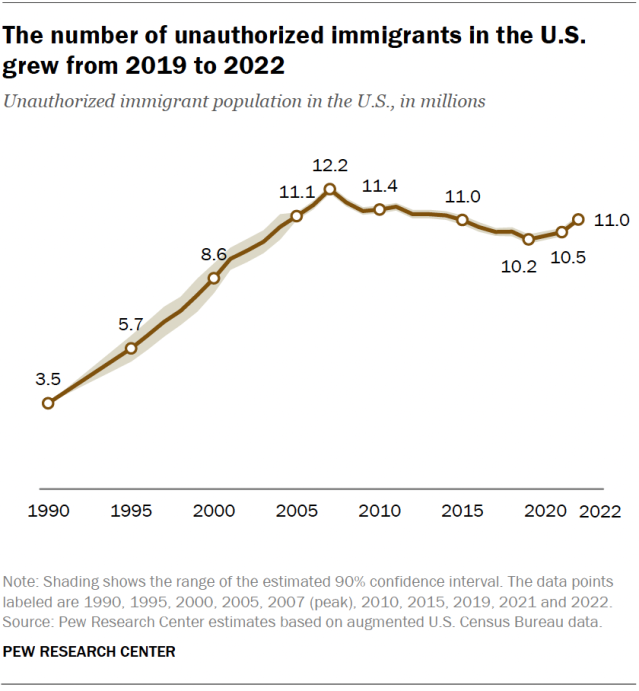
From 2019 to 2022, the number of unauthorized immigrants from other parts of the world, like the Caribbean, South America, Asia, Europe, and Africa, increased. The most significant growth was in Florida, Maryland, Massachusetts, New Jersey, New York, and Texas. California was the only state where the number went down.
Unauthorized Immigrants in the Workforce
In 2022, 8.3 million workers in the U.S. were unauthorized immigrants, up from 7.4 million in 2019. They made up about 4.8% of all workers in the U.S. Most unauthorized immigrants live in six states: California, Texas, Florida, New York, New Jersey, and Illinois. These states have had the highest numbers of unauthorized immigrants since 1980.
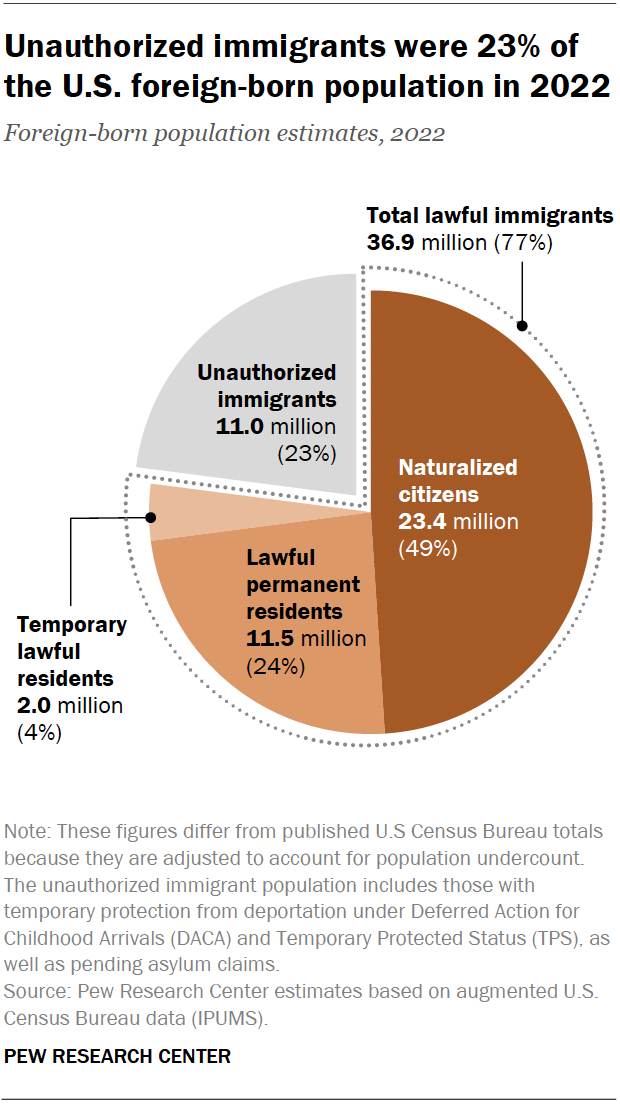
Where Unauthorized Immigrants Live
Unauthorized immigrants live in about 6.3 million households in the U.S., which means they live with more than 22 million people. Most of these households include both unauthorized immigrants and U.S. citizens or legal residents. Around 4.4 million children who are U.S. citizens live with unauthorized immigrant parents.
What Countries Do They Come From?
Most unauthorized immigrants used to come from Mexico, but now the numbers are lower. In 2022, Mexico made up only 37% of unauthorized immigrants, the smallest share ever. Other countries, like El Salvador, Guatemala, India, and Honduras, have seen their numbers grow.
The biggest increases came from the Caribbean, Europe, and Canada. Countries like Brazil, Colombia, and Venezuela have also seen a rise in the number of unauthorized immigrants.
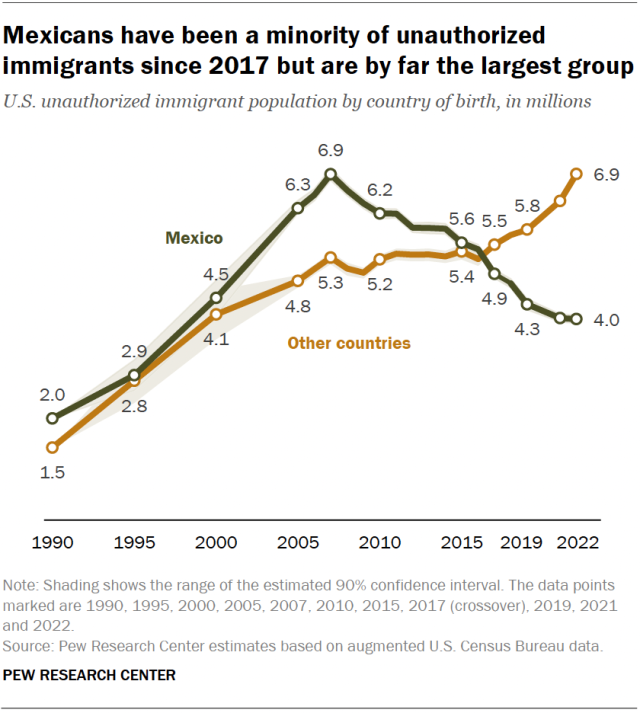
The 4.0 million unauthorized immigrants from Mexico living in the U.S. in 2022 was the lowest number since the 1990s. And in 2022, Mexico accounted for 37% of the nation’s unauthorized immigrants, by far the smallest share on record.
The decrease in unauthorized immigrants from Mexico reflects several factors:
- A broader decline in migration from Mexico to the U.S.;
- Some Mexican immigrants returning to Mexico; and
- Expanded opportunities for lawful immigration from Mexico and other countries, especially for temporary agricultural workers.
The rest of the world
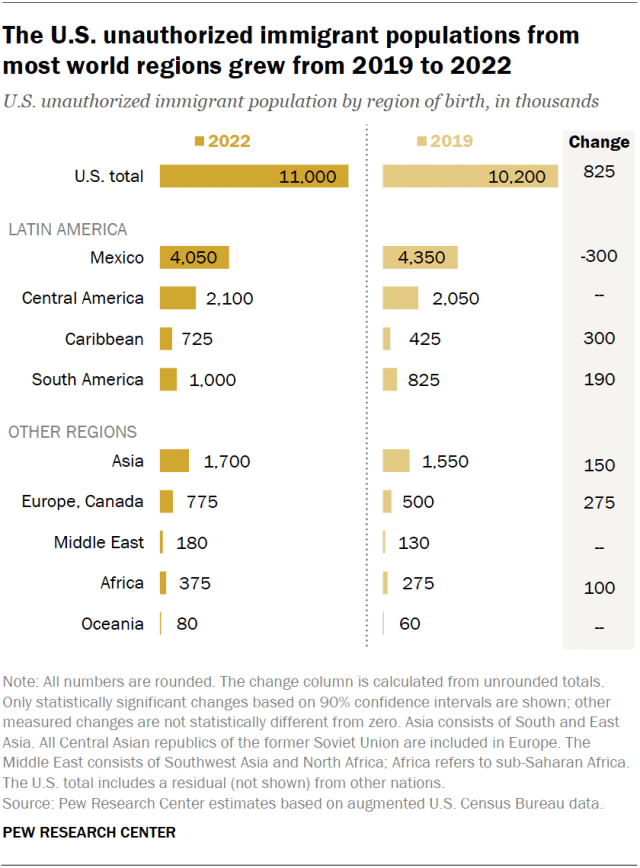
The total number of unauthorized immigrants in the U.S. from countries other than Mexico grew rapidly between 2019 and 2022, from 5.8 million to 6.9 million.
The number of unauthorized immigrants from almost every world region increased. The largest increases were from the Caribbean (300,000) and Europe and Canada (275,000). One exception was Central America, which had led in growth until 2019 but saw no change after that.
After Mexico, the countries with the largest unauthorized immigrant populations in the U.S. in 2022 were:
- El Salvador (750,000)
- India (725,000)
- Guatemala (675,000)
- Honduras (525,000)
The Northern Triangle
Three Central American countries – El Salvador, Honduras and Guatemala – together represented 1.9 million unauthorized immigrants in the U.S. in 2022, or about 18% of the total. The unauthorized immigrant population from the Northern Triangle grew by about 50% between 2007 and 2019 but did not increase significantly after that.
Other origin countries
In 2022, Venezuela was the country of birth for 270,000 U.S. unauthorized immigrants. This population had seen particularly fast growth, from 55,000 in 2007 to 130,000 in 2017. It is poised to grow significantly in the future as new methods of entry to the U.S. are now available to Venezuelans.
Other countries with large numbers of unauthorized immigrants have also seen increases in recent years. Brazil, Canada, Colombia, Ecuador, India, and countries making up the former Soviet Union all experienced growth from 2019 to 2022.
However, other countries with significant unauthorized immigrant populations showed no change, notably China, the Dominican Republic and the Philippines.
Detailed table: Unauthorized immigrant population by region and selected country of birth (and margins of error), 1990-2022 (Excel)
Which states do unauthorized immigrants call home?
Most U.S. states’ unauthorized immigrant populations stayed steady from 2019 to 2022. However, six states showed significant growth:
- Florida (+400,000)
- Texas (+85,000)
- New York (+70,000)
- New Jersey (+55,000)
- Massachusetts (+50,000)
- Maryland (+40,000)
California (-120,000) is the only state whose unauthorized immigrant population decreased.
States with the most unauthorized immigrants
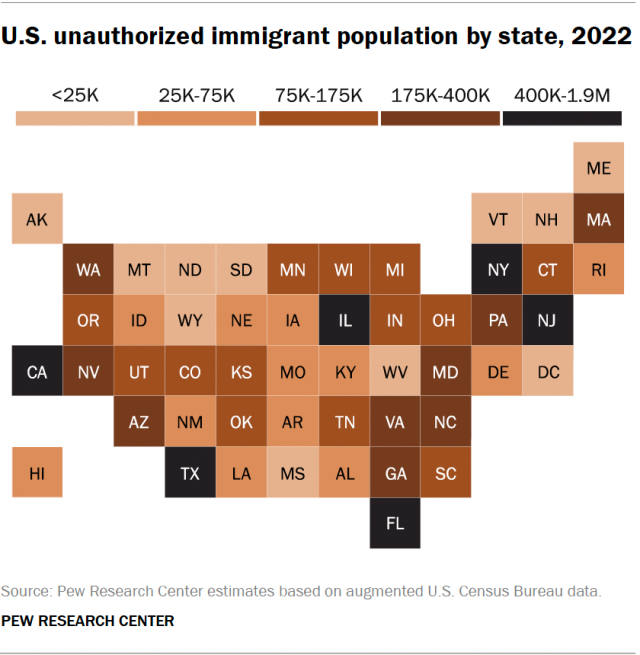
The six states with the largest unauthorized immigrant populations in 2022 were:
- California (1.8 million)
- Texas (1.6 million)
- Florida (1.2 million)
- New York (650,000)
- New Jersey (475,000)
- Illinois (400,000)
These states have consistently had the most unauthorized immigrants since at least 1980. However, in 2007, California had 1.2 million more unauthorized immigrants than Texas. Today, with the declining number in California, it has only about 150,000 more. The unauthorized immigrant population has also become considerably less geographically concentrated over time. In 2022, the top six states were home to 56% of the nation’s unauthorized immigrants, down from 80% in 1990.
Detailed table: Unauthorized immigrant population for states (and margins of error), 1990-2022 (Excel)
Detailed table: Unauthorized immigrants and characteristics for states, 2022 (Excel)
Unauthorized immigrants in the labor force
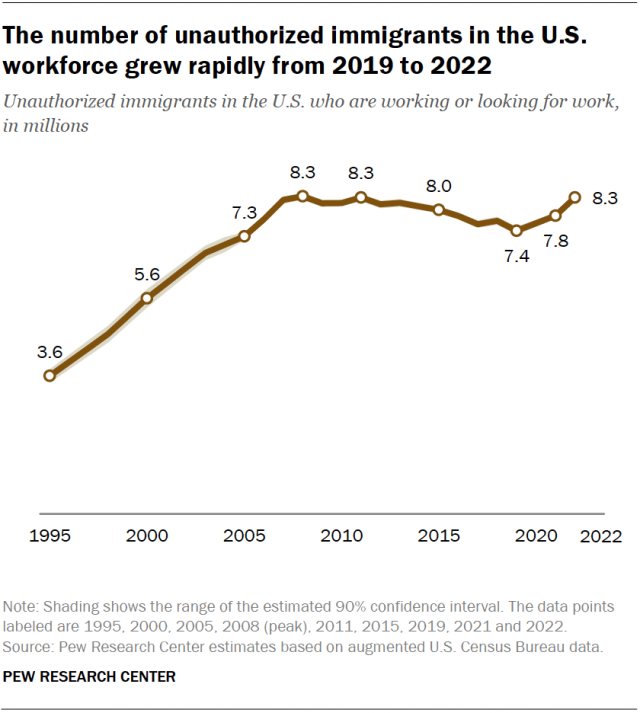
Conclusion
The number of unauthorized immigrants in the U.S. is changing. While the population grew slightly from 2019 to 2022, it is still below the peak in 2007. People from more regions of the world are now coming to the U.S., and many unauthorized immigrants live and work in the country, contributing to its workforce.





No responses yet